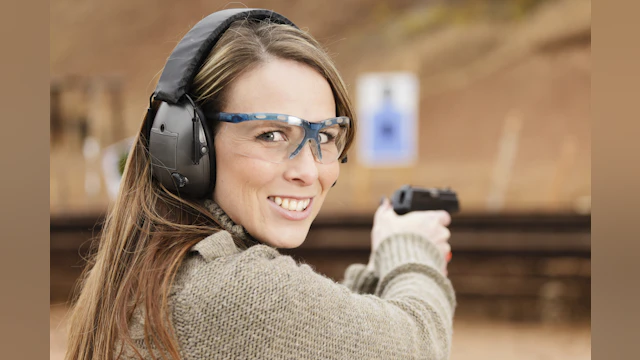Firearms policy
AFSP supports legislation to expand research and public education on suicide and firearms; voluntary removal and safe storage initiatives; lethal means counseling; and the use of Extreme Risk Protection Orders (ERPOs) when necessary.
About the issue
There is no one single cause of suicide. We all have mental health, just like we all have physical health. Conditions like depression, anxiety, and substance use problems, especially when unaddressed, increase risk for suicide. We also know that risk is greater when a firearm or other lethal means are present in the home or readily accessible.
Ensuring that a person at acute risk for suicide does not have easy access to a firearm is important for suicide prevention. Temporary removal or safe storage of a firearm allows for time and space between a highly lethal method of suicide and a person who has an urge to act on thoughts of suicide as well as an increased chance of survival of a suicide attempt if a highly lethal method is not easily accessed. This is especially important since firearms are highly lethal and most suicide attempts with a firearm (85-90%) end in death. Furthermore, in 2021, 55% of suicides were by firearm and 54% of firearm deaths were suicides. Research shows that when a chosen method of suicide is not accessible, most people will not move on to another method in a moment of crisis.
Voluntary action to make the environment safe from lethal means, including firearms, is therefore an essential component in any effective suicide prevention plan. Putting time and distance between a person in suicidal crisis and a lethal method can save lives by giving them something they desperately need: time for the intense suicidal risk to diminish or for someone to intervene with mental health support and resources.
Most individuals who are prevented from making a suicide attempt via one method typically do not go on to attempt with another method. If we can prevent a person who intends to die by firearm suicide from attempting with that firearm, they will likely not go on to attempt with another method, and if they do that method will have a lower likelihood of being lethal.
Our policy position
AFSP urges support on the federal and state level for firearms-related legislation to prioritize research and provide education on the relationship between suicide and firearms, implement voluntary removal initiatives, and expand lethal means education and counseling practices within healthcare systems.
Public investments to support research regarding firearms and suicide prevention
More data is needed on which firearm policies are most effective in reducing suicide rates, which educational efforts are most effective in changing attitudes and behaviors around firearms and suicide risk, and how best to bring promising practices to scale so we can affect more widespread change nationwide.
Laws that call for the creation and dissemination of educational materials and/or training regarding lethal means and suicide prevention and/or safe storage
These include efforts to publish and distribute pamphlets/brochures on firearms safety and suicide prevention; distribute cable-style gun locks to health care providers and crisis outreach teams; create suicide prevention education courses for firearms instructors or include suicide prevention content as part of existing firearms safety/education courses or materials; require training in suicide prevention and/or safe storage (firearm safety course) for gun range owners, firearm dealers, firearm purchases, and/or concealed permits, etc.; and put suicide prevention information on firearm warning labels and premises of licensed dealers.
Voluntary removal initiatives
These include community storage options for temporarily storing your guns outside the home such as gun shops, shooting ranges, police departments, and special storage facilities; temporary transfer exceptions in background check laws in cases of suicide risk; and voluntary Do-Not-Sell List programs that authorize individuals to add their own names into the background check system to protect themselves against future impulsive firearm suicide attempts.
Training for healthcare professionals on the importance of lethal means counseling in the treatment of individuals experiencing a suicide crisis
When a patient is at risk of suicide, and there is access to a firearm in the home, healthcare professionals should work with the patient and their family on voluntary strategies to store household firearms away from the home, or otherwise inaccessibly, until the patient recovers.
Extreme Risk Protection Orders (ERPOs)
AFSP also urges lawmakers to support legislation to create a process for Extreme Risk Protection Orders (ERPOs) as a tool to help prevent suicide when voluntary efforts to separate an at-risk individual from a firearm are unsuccessful or impossible and suicide risk is imminent. AFSP does not support all ERPO legislation but evaluates each bill individually. The top consideration is timing or urgency of a court decision (i.e., does the bill provide for emergency or ex parte orders to ensure safety during times of suicide risk). Additional main considerations are below:
- Urgency of a court decision to prevent suicide: ERPO bills should provide for emergency or ex parte orders that immediately remove the firearm from an individual at risk to keep them safe.
- Consideration of risk factors for suicide: Suicide is complex and multiple risk and historical factors must be considered. An at-risk person’s mental health history must not be the sole criteria used for determining whether to issue an ERPO.
- Due process protections: ERPO bills should set a high standard for securing an order and provide for due process protections for the at-risk individual and for the individual petitioning the court.
- Development and accessibility of related educational materials: ERPO bills should address educating the public about what an ERPO law is, who may file a petition, and the steps to take when filing a petition. See California’s Speak for Safety campaign as an example.
- Data collection: ERPO bills should require statewide data collection and reporting regarding use of ERPOs.
Informational resources available for download
Additional AFSP resources
View our Preventing Firearm Suicide webinar to learn more about our work on state and federal firearms-related legislation and what advocacy around this issue looks like.
See afsp.org/firearms to learn more about AFSP’s efforts to provide lifesaving suicide prevention education for communities and homes where firearms are present, as well as wide-scale adoption of suicide prevention education as a basic tenet of firearm safety and responsible gun ownership.
In order to reach the primary goal of educating as many firearms owners as possible about suicide and its prevention, AFSP collaborates with a national firearms industry trade association (the National Shooting Sports Foundation, or NSSF) and others to educate gun owners and their families across the U.S. about suicide prevention, including the risk factors and warning signs, the need for safe storage (locked and unloaded) to help prevent suicide, and how voluntarily removing guns from the home when someone is struggling with a mental health crisis and/or thoughts of suicide can help to save lives.
In September 2024, AFSP and the National ERPO Resource Center cohosted the webinar Extreme Risk Protection Orders: An Effective Tool to Prevent Firearm Suicides.
Focus on Firearms

I want to understand more about firearms and suicide
Firearms are involved in over 50% of all suicides in the U.S., and AFSP is leading the effort to educate firearm owners to prevent this leading cause of death. Suicide also accounts for most firearm deaths in the U.S.

Protecting yourself and others
Firearm owners and people that live in households with firearms must take action to protect against suicide.

Firearm retailers, ranges, and instructors
By recognizing the unique needs of firearm ranges, retailers, instructors, and other firearm industry sectors, AFSP is helping to connect firearms owners with life-saving information about suicide prevention and secure firearm storage.